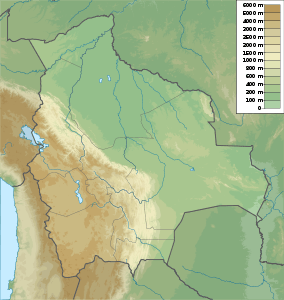Cerro Rico
| Cerro Rico | |
|---|---|
| Sumaq Urqu | |
 View of Cerro Rico from Potosí | |
| Elevation | 4,782 m (15,689 ft) |
| Location | |
 Cerro Rico Location in Bolivia | |
| Location | Bolivia, Potosí |
| Range | Andes |
| Coordinates | 19°37′8″S 65°44′59″W / 19.61889°S 65.74972°WCoordinates: 19°37′8″S 65°44′59″W / 19.61889°S 65.74972°W |
Cerro Rico (also called Cerro de Potosí, Quechua Sumaq Urqu) is a mountain in the Andes near the Bolivian city of Potosí. Cerro Rico was famous for providing vast quantities of silver for Spain during the period of the New World Spanish Empire. The mountain, which is popularly conceived of as being "made of" silver ore, caused the city of Potosí to become one of the largest cities in the New World. After 1800, the silver mines were depleted, making tin the main product. This eventually led to a slow economic decline. Nevertheless, the mountain continues to be mined for silver to this day. Due to poor worker conditions, such as a lack of protective equipment against the constant inhalation of dust, many of the miners contract silicosis and have a life expectancy of around 40 years. The mountain is still a significant contributor to the city's economy, employing some 15,000 miners.
It is known as 'mountain that eats men' because of the large number of workers who died in the mines. Some historians estimate that up to 8 million men have died in the Cerro Rico since the 16th century.[1]
As a result of centuries long mining, in 2011 a sinkhole in the top appeared and had to be filled with ultra-light cement. The summit also continues to sink a few centimetres every year.[2] In 2014, UNESCO added Cerro Rico and Potosí to its list of endangered sites, owing to "uncontrolled mining operations" that risk "degrading the site".[1]
Mine
The Cerro Rico de Potosí mine is one of the largest silver mines in Bolivia and in the world.[3] The mine is located in the south of the country in Potosí Department.[3] The mine has estimated reserves of 1.76 billion oz of silver and 540 million tonnes of ore grading 0.17% tin.[3]